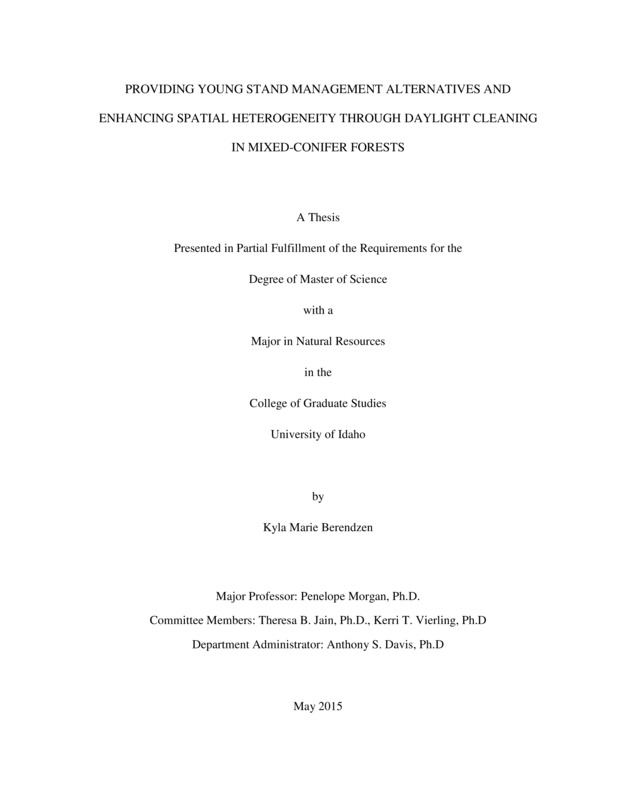Providing young stand management alternatives and enhancing spatial heterogeneity through daylight cleaning in mixed-conifer forests
Berendzen, Kyla. (2015). Providing young stand management alternatives and enhancing spatial heterogeneity through daylight cleaning in mixed-conifer forests. Theses and Dissertations Collection, University of Idaho Library Digital Collections. https://www.lib.uidaho.edu/digital/etd/items/berendzen_idaho_0089n_10543.html
- Title:
- Providing young stand management alternatives and enhancing spatial heterogeneity through daylight cleaning in mixed-conifer forests
- Author:
- Berendzen, Kyla
- Date:
- 2015
- Embargo Remove Date:
- 2016-05-12
- Keywords:
- biocomplexity plantations pre-commercial thinning variable-density thinning western white pine
- Program:
- Natural Resources
- Subject Category:
- Forestry
- Abstract:
-
Throughout western North American forests, harvests of recent decades have created an abundance of young, even-aged stands. In the Inland Northwest over 120,000 ha of young western white pine plantations now urgently need management to maintain their health and resilience. Traditional precommercial thinning practices promote growth of desirable crop trees but are expensive and create homogeneous conditions. I compared the effectiveness, spatial heterogeneity, and growth environments of daylight cleaning treatments that cleared 4-m radii around crop trees to full cleaning treatments at regular spacings and to untreated controls across three replicates in 30-year-old western white pine plantations. The daylight cleaning method is a partial cleaning method that left portions of the stand untreated, cleaning just 27% of the stand areas with the remainder left as untreated matrix. However, similar densities of western white pine crop trees were released in the daylighted stands as in fully cleaned stands, and conditions were more heterogeneous in the daylighted stands. Around the daylighted crop trees, gap sizes, stand structure, fuels, predicted fire behavior, and microclimates were highly variable but more similar to fully cleaned conditions than to those of the control. Daylight cleaning can provide a cost-effective opportunity to conduct stand tending across more young forest plantations than would be possible with full cleanings. The partial cleaning concepts applied to daylight cleaning can be modified for different sites, species, and tree density objectives to provide a broad range of alternatives to maximize young stand spatial heterogeneity and resilience to disturbances and changing conditions at stand and landscape scales.
- Description:
- masters, M.S., Natural Resources -- University of Idaho - College of Graduate Studies, 2015
- Major Professor:
- Morgan, Penelope; Jain, Teresa B
- Committee:
- Morgan, Penelope; Jain, Teresa B; Vierling, Kerri T
- Defense Date:
- 2015
- Identifier:
- Berendzen_idaho_0089N_10543
- Type:
- Text
- Format Original:
- Format:
- application/pdf
- Rights:
- In Copyright - Educational Use Permitted. For more information, please contact University of Idaho Library Special Collections and Archives Department at libspec@uidaho.edu.
- Standardized Rights:
- http://rightsstatements.org/vocab/InC-EDU/1.0/

